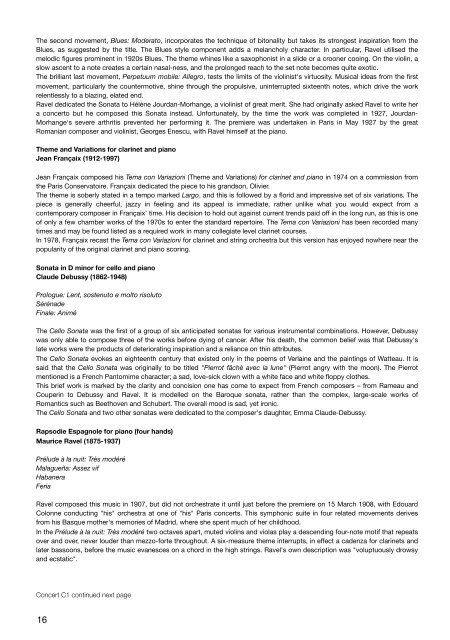Here - Tyalgum Festival of Classical Music
Here - Tyalgum Festival of Classical Music
Here - Tyalgum Festival of Classical Music
You also want an ePaper? Increase the reach of your titles
YUMPU automatically turns print PDFs into web optimized ePapers that Google loves.
The second movement, Blues: Moderato, incorporates the technique <strong>of</strong> bitonality but takes its strongest inspiration from the<br />
Blues, as suggested by the title. The Blues style component adds a melancholy character. In particular, Ravel utilised the<br />
melodic figures prominent in 1920s Blues. The theme whines like a saxophonist in a slide or a crooner cooing. On the violin, a<br />
slow ascent to a note creates a certain nasal-ness, and the prolonged reach to the set note becomes quite exotic.<br />
The brilliant last movement, Perpetuum mobile: Allegro, tests the limits <strong>of</strong> the violinist's virtuosity. <strong>Music</strong>al ideas from the first<br />
movement, particularly the countermotive, shine through the propulsive, uninterrupted sixteenth notes, which drive the work<br />
relentlessly to a blazing, elated end.<br />
Ravel dedicated the Sonata to Hélène Jourdan-Morhange, a violinist <strong>of</strong> great merit. She had originally asked Ravel to write her<br />
a concerto but he composed this Sonata instead. Unfortunately, by the time the work was completed in 1927, Jourdan-<br />
Morhange's severe arthritis prevented her performing it. The premiere was undertaken in Paris in May 1927 by the great<br />
Romanian composer and violinist, Georges Enescu, with Ravel himself at the piano.<br />
Theme and Variations for clarinet and piano<br />
Jean Françaix (1912-1997)<br />
Jean Françaix composed his Tema con Variazioni (Theme and Variations) for clarinet and piano in 1974 on a commission from<br />
the Paris Conservatoire. Françaix dedicated the piece to his grandson, Olivier.<br />
The theme is soberly stated in a tempo marked Largo, and this is followed by a florid and impressive set <strong>of</strong> six variations. The<br />
piece is generally cheerful, jazzy in feeling and its appeal is immediate, rather unlike what you would expect from a<br />
contemporary composer in Françaix' time. His decision to hold out against current trends paid <strong>of</strong>f in the long run, as this is one<br />
<strong>of</strong> only a few chamber works <strong>of</strong> the 1970s to enter the standard repertoire. The Tema con Variazioni has been recorded many<br />
times and may be found listed as a required work in many collegiate level clarinet courses.<br />
In 1978, Françaix recast the Tema con Variazioni for clarinet and string orchestra but this version has enjoyed nowhere near the<br />
popularity <strong>of</strong> the original clarinet and piano scoring.<br />
Sonata in D minor for cello and piano<br />
Claude Debussy (1862-1948)<br />
Prologue: Lent, sostenuto e molto risoluto<br />
Sérénade<br />
Finale: Animé<br />
The Cello Sonata was the first <strong>of</strong> a group <strong>of</strong> six anticipated sonatas for various instrumental combinations. However, Debussy<br />
was only able to compose three <strong>of</strong> the works before dying <strong>of</strong> cancer. After his death, the common belief was that Debussy's<br />
late works were the products <strong>of</strong> deteriorating inspiration and a reliance on thin attributes.<br />
The Cello Sonata evokes an eighteenth century that existed only in the poems <strong>of</strong> Verlaine and the paintings <strong>of</strong> Watteau. It is<br />
said that the Cello Sonata was originally to be titled "Pierrot fâchè avec la lune" (Pierrot angry with the moon). The Pierrot<br />
mentioned is a French Pantomime character; a sad, love-sick clown with a white face and white floppy clothes.<br />
This brief work is marked by the clarity and concision one has come to expect from French composers – from Rameau and<br />
Couperin to Debussy and Ravel. It is modelled on the Baroque sonata, rather than the complex, large-scale works <strong>of</strong><br />
Romantics such as Beethoven and Schubert. The overall mood is sad, yet ironic.<br />
The Cello Sonata and two other sonatas were dedicated to the composer's daughter, Emma Claude-Debussy.<br />
Rapsodie Espagnole for piano (four hands)<br />
Maurice Ravel (1875-1937)<br />
Prélude à la nuit: Très modéré<br />
Malagueña: Assez vif<br />
Habanera<br />
Feria<br />
Ravel composed this music in 1907, but did not orchestrate it until just before the premiere on 15 March 1908, with Edouard<br />
Colonne conducting "his" orchestra at one <strong>of</strong> "his" Paris concerts. This symphonic suite in four related movements derives<br />
from his Basque mother's memories <strong>of</strong> Madrid, where she spent much <strong>of</strong> her childhood.<br />
In the Prélude à la nuit: Très modéré two octaves apart, muted violins and violas play a descending four-note motif that repeats<br />
over and over, never louder than mezzo-forte throughout. A six-measure theme interrupts, in effect a cadenza for clarinets and<br />
later bassoons, before the music evanesces on a chord in the high strings. Ravel's own description was "voluptuously drowsy<br />
and ecstatic".<br />
Concert C1 continued next page<br />
16



